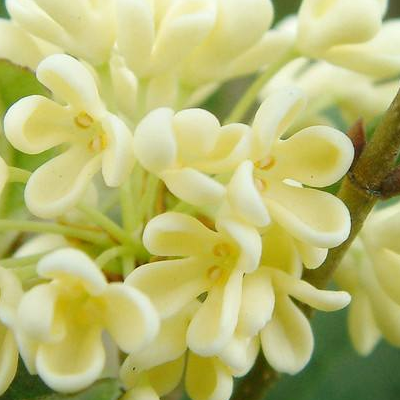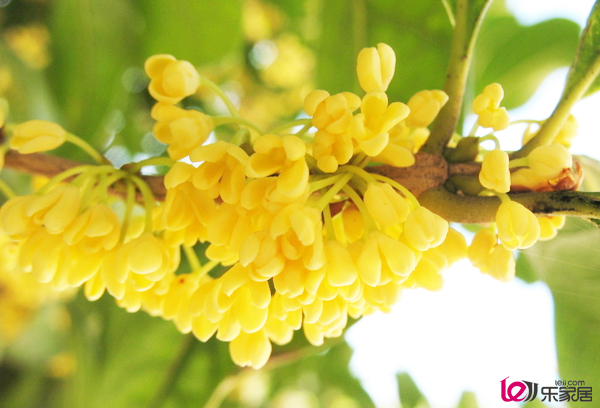Grafting method of Osmanthus fragrans
Osmanthus fragrans grafting method, sweet-scented osmanthus grafting, mainly branch grafting. In Wuhan and Nanjing, the best grafting period is from late March to April. At this time, the rootstock began to find new buds, the sap flowed and healed quickly after grafting. The scion should be a 1-2-year-old branch cut from a young and middle-aged mother tree with good varieties, strong growth, flowering and free of diseases and insect pests. As the sweet-scented osmanthus blossoms late, in order to blossom and put into production earlier, we must choose older branches with flower buds as scions, rather than upright long branches and inner branches as scions.
Early morning is the best time to cut the scion. Once the scion leaves the mother, the leaf should be cut off immediately, leaving the petiole, and keep it moist, so as not to affect the survival of grafting due to the loss of water from leaf transpiration. Cut the scion from far away and protect it with wet moss to keep it fresh. For those who are grafted with local materials, it is best to pick them along with them.
The grafting methods of sweet-scented osmanthus include cutting, splitting, skin grafting, abdominal grafting and so on. As sweet-scented osmanthus is grafted, it is better to promote self-rooting, so the grafting position should not be too high. However, the grafting of non-deciduous plants requires the retention of leaves, which is conducive to survival, so abdominal grafting is the best.
The grafting site is 5 cm above the ground of the rootstock. After inserting the scion, use ultra-thin plastic film, cut into plastic rolls 10 cm wide, take 30ml 40 cm long, wrap the scion and the grafting mouth first, make the scion top with the film. After wrapping, move the plastic film down, merge the film into a rope, wrap it around the crack under the interface several times, tie the interface tightly, and finally, pierce the plastic rope through the upper circle, and then tighten it. This bandaging method can also be used for all kinds of truncated grafting, such as cutting, split grafting and so on. However, it is difficult to cover plastic pockets for abdominal connection, and it is not suitable for evergreen trees to seal scions with wax, so plastic film wrapping is an efficient and labor-saving method, which can not only maintain the humidity of the interface, play a role in heat preservation and moisturizing, but also prevent Rain Water from soaking, and the scion is not drained.
After ventral grafting, all the leaves of the rootstock should be retained, as long as the heart is removed to control the growth of the rootstock. After 10 times, the wound healed. After leaving 5 leaves on the rootstock at the interface, the upper rootstock was cut off. After another week, the scion has begun to sprout, that is, cut off the rootstock 1 cm above the scion and cut the wrapped plastic film so that the scion bud can grow. In this way, through gradually cutting the rootstock, on the one hand, the nutrients produced by the leaves of the rootstock can promote the healing and growth of the scion, and can make use of the normal activity of the root system, on the other hand, it can stimulate the germination and growth of the scion bud, which is the grafting method of sweet osmanthus.
When will the grafting method of Osmanthus fragrans be good?
Sweet-scented osmanthus, which is liked by many people, if this sweet-scented osmanthus blossoms, it is really fragrant, what is the grafting method of sweet-scented osmanthus? When will sweet-scented osmanthus be grafted:

Grafting method of Osmanthus fragrans
Grafting method: abdominal grafting and leaning grafting are generally used.
1. Ventral connection: this kind of ventral connection is to trim the rootstock before joining, cut off all the rootstocks at 6mur7cm from the soil surface, and cut obliquely near the rhizome. The medulla must not be injured. The scion uses 2 Mel 3 to produce branches (without leaves), about 10 cm long. It is more appropriate to have 2 Mel 3 sections. Then the ear interface is cut into an unequal wedge and inserted into the cutting of the rootstock to make it close. Tie it with plastic or hemp skin and choke the soil to the top of the scion.
2. Leaning on: the rootstock is first fed in a basin. Generally speaking, the branches of two-year-old sweet-scented osmanthus seedlings which are similar in thickness to the rootstock are selected during the Meiyu period from June to July, and cut off in front of "White Dew" after survival. That is, the new plant, which can blossom in the same year.
3. After the grafting survived, when the new graft is slightly as long as 10-15 cm. At this time, all the remaining branches and tillers of the rootstock can be cut off. As the anvil is easy to sprout adventitious buds, it should be peeled off at any time. Drought resistance, topdressing and weeding were carried out from June to August. Potted seedlings should be coring when the new shoots reach about 15%, which can promote the growth of lateral branches and form a shrub.
When will Osmanthus fragrans be grafted?
Grafting sweet-scented osmanthus in early spring is better, and it will be able to determine whether it will survive or not, which is conducive to management. Osmanthus fragrans can also be grafted in autumn, and the survival rate of master grafting is relatively high.
This is the end of the introduction of the method of grafting of sweet-scented osmanthus. We should pay attention to the method of grafting.
Sweet-scented osmanthus grafting method | how to graft sweet-scented osmanthus? What are the grafting methods of Osmanthus fragrans? This paper mainly introduces how sweet-scented osmanthus is grafted. There are many methods of sweet-scented osmanthus grafting, among which the grafting method is commonly used in potted sweet-scented osmanthus in China. Its advantages are: long time for grafting, easy to survive, fast forming and early flowering. The key points of osmanthus fragrance joining technology are introduced as follows:
I. grafting method
⑴ moved the scion closer to the rootstock. The branches of sweet-scented osmanthus selected as scions can be close to the branches of rootstocks by means of support, cushion, frame, hanging, binding and so on. Then determine the suitable grafting position of rootstock and scion, and fix the position.
⑵ cutting interface bevel. The interface bevel was cut at the grafting site between the rootstock and the scion. The slope is oval in shape, the length is 3-5cm, and the depth of the slope is generally no more than half of the thickness of the branch.
⑶ cutting anvil. After the grafting and binding is completed, cut off the branches of the rootstock 1 cm above the interface.
⑷ to remove cuteness. After grafting, if the branches germinate below the interface of the rootstock, it should be erased in time. 31-35 days after grafting, the scion was cut off from the interface and separated from the mother.
The survival rate was checked by ⑸. 3-5 days after cutting the scion, the scion branches and leaves grow normally is to survive; if the leaves appear wilt II, cultivate rootstocks grafting sweet-scented osmanthus rootstock species are privet, tassel tree and so on. The rootstocks for grafting should be robust and free from diseases and insect pests, 2-3-year-old seedlings with a diameter of more than 1 cm or 2-3-year-old branches on perennial trees.
Third, the selection of scion sweet-scented osmanthus has Jin Gui, Yin Gui, Dan Gui, Siji Gui and other varieties. First of all, sweet-scented osmanthus varieties can be selected according to their preferences and resource conditions, and then 2-3-year-old branches with strong growth, full development, no disease and insect harm and moderate size can be selected as scions.
- Prev

How to graft sweet-scented osmanthus
How to graft sweet-scented osmanthus, sweet-scented osmanthus is one of the top ten famous flowers in China. Sweet-scented osmanthus is evergreen all the year round, full of fragrance and fragrance, making it the crown of all flowers. Osmanthus fragrans is not only a garden tree species for greening, beautification and fragrance of the environment, but also an economic tree species for special use in spices, food, wine, medicine and so on.
- Next

Planting method of Osmanthus fragrans
Sweet-scented osmanthus tree planting method, sweet-scented osmanthus tree, also known as rhinoceros, rock cinnamon, golden millet and so on. When it is in full bloom, it is full of yellow flowers, overflowing with the wind, fragrant and refreshing, with the praise of "monopolizing Sanqiu pressure Zhongfang, he Kua orange green and orange yellow". In addition, it has high economic value, and flowers can be used as raw materials for food processing.
Related
- Fuxing push coffee new agricultural production and marketing class: lack of small-scale processing plants
- Jujube rice field leisure farm deep ploughing Yilan for five years to create a space for organic food and play
- Nongyu Farm-A trial of organic papaya for brave women with advanced technology
- Four points for attention in the prevention and control of diseases and insect pests of edible fungi
- How to add nutrient solution to Edible Fungi
- Is there any good way to control edible fungus mites?
- Open Inoculation Technology of Edible Fungi
- Is there any clever way to use fertilizer for edible fungus in winter?
- What agents are used to kill the pathogens of edible fungi in the mushroom shed?
- Rapid drying of Edible Fungi

